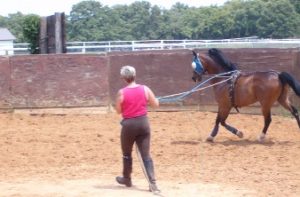Training Philosophy and Goals

The goal of training is to establish two-way communication between you and your horse, so when you ask something of him, his response is compliance with your request, whether you are handling him on the ground or are mounted on his back.
At Tezmaral, the language of communication is pressure and absence of pressure. The horse is taught boundaries using pressure, and is rewarded for the correct response with the absence of pressure. “Pressure” is contextual and is used to guide the horse to the desired response in a certain situation; when the horse complies, pressure is relieved. For example, using your legs as an aid to move your horse forward is pressure; when he moves forward, you remove the application of leg and relieve the pressure.
Our training methods facilitate your goal to feel comfortable with your horse on the ground or on their back, and that confidence comes from an understanding of basic principles that the horse is taught. These basic principles include:
- Being easily caught and haltered in a stall, pen, or pasture
- Leading
- Being cross-tied or single tied
- Standing quietly for grooming and saddling
- Readily accepting being bridled
- Standing quietly for the farrier or vet
- Lunging in a circle on a line in both directions
- Trailer loading and unloading
For example, when you are leading a horse, the correct position is between their head and the shoulder on the left side of the horse. You should not have to pull the horse, nor should he drag you. The horse must learn these boundaries and then the behavior is reinforced by continuous repetition.
These basic principles help the horse understand what is expected of him so he knows how to comply with a positive response. It also makes the next phase, learning bitting skills, much easier. Directing the horse from the ground in long lines, the handler teaches the horse to carry the bit in his mouth and move forward, turn, and stop when asked. Once bitting skills are learned and the horse readily responds, then it is time to mount up.
By this stage the horse has learned to accept pressures from both the equipment and the handler. Throwing a leg over their back is no big event. Confidence and understanding is gained by the use of the bridle and the horse carries the rider with ease.
The time necessary to progress through these training periods depends on the horse and the desired response level of the intended rider. Each horse is a unique individual – both mentally and physically – and training is adapted accordingly to help each horse succeed.
Throughout the process, we work with you and your horse as a team to ensure you understand how to communicate with your horse using the language he has been taught. By making requests of your horse in a way that he understands, he is happy to comply, and your relationship will be positive for you both.
